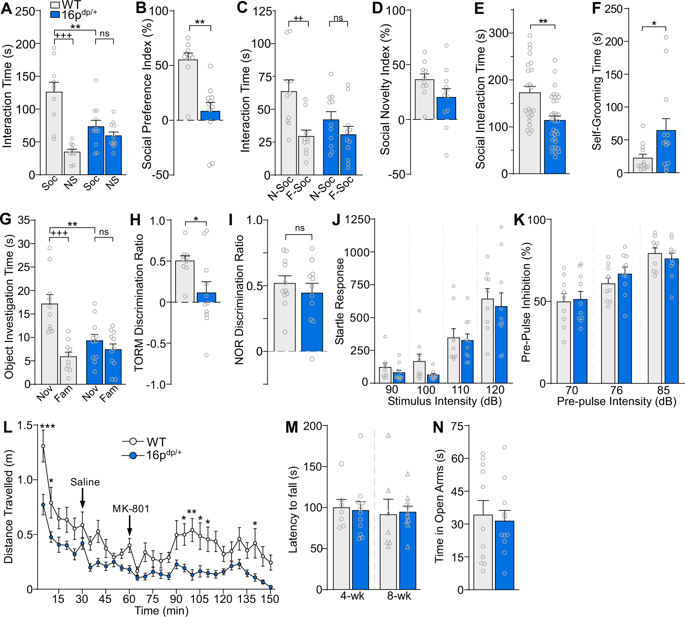当前位置:
X-MOL 学术
›
Mol. Psychiatry
›
论文详情
Our official English website, www.x-mol.net, welcomes your feedback! (Note: you will need to create a separate account there.)
Reversal of synaptic and behavioral deficits in a 16p11.2 duplication mouse model via restoration of the GABA synapse regulator Npas4.
Molecular Psychiatry ( IF 11.0 ) Pub Date : 2020-02-25 , DOI: 10.1038/s41380-020-0693-9 Benjamin Rein 1 , Tao Tan 1 , Fengwei Yang 1 , Wei Wang 1 , Jamal Williams 1 , Freddy Zhang 1 , Alea Mills 2 , Zhen Yan 1
Molecular Psychiatry ( IF 11.0 ) Pub Date : 2020-02-25 , DOI: 10.1038/s41380-020-0693-9 Benjamin Rein 1 , Tao Tan 1 , Fengwei Yang 1 , Wei Wang 1 , Jamal Williams 1 , Freddy Zhang 1 , Alea Mills 2 , Zhen Yan 1
Affiliation

|
The human 16p11.2 gene locus is a hot spot for copy number variations, which predispose carriers to a range of neuropsychiatric phenotypes. Microduplications of 16p11.2 are associated with autism spectrum disorder (ASD), intellectual disability (ID), and schizophrenia (SZ). Despite the debilitating nature of 16p11.2 duplications, the underlying molecular mechanisms remain poorly understood. Here we performed a comprehensive behavioral characterization of 16p11.2 duplication mice (16p11.2dp/+) and identified social and cognitive deficits reminiscent of ASD and ID phenotypes. 16p11.2dp/+ mice did not exhibit the SZ-related sensorimotor gating deficits, psychostimulant-induced hypersensitivity, or motor impairment. Electrophysiological recordings of 16p11.2dp/+ mice found deficient GABAergic synaptic transmission and elevated neuronal excitability in the prefrontal cortex (PFC), a brain region critical for social and cognitive functions. RNA-sequencing identified genome-wide transcriptional aberrance in the PFC of 16p11.2dp/+ mice, including downregulation of the GABA synapse regulator Npas4. Restoring Npas4 expression in PFC of 16p11.2dp/+ mice ameliorated the social and cognitive deficits and reversed GABAergic synaptic impairment and neuronal hyperexcitability. These findings suggest that prefrontal cortical GABAergic synaptic circuitry and Npas4 are strongly implicated in 16p11.2 duplication pathology, and may represent potential targets for therapeutic intervention in ASD.
中文翻译:

通过恢复 GABA 突触调节器 Npas4 逆转 16p11.2 复制小鼠模型中的突触和行为缺陷。
人类 16p11.2 基因位点是拷贝数变异的热点,它使携带者易患一系列神经精神表型。16p11.2 的微复制与自闭症谱系障碍 (ASD)、智力障碍 (ID) 和精神分裂症 (SZ) 相关。尽管 16p11.2 重复具有使人衰弱的性质,但其潜在的分子机制仍然知之甚少。在这里,我们对 16p11.2 复制小鼠 (16p11.2dp/+) 进行了全面的行为表征,并确定了让人联想到 ASD 和 ID 表型的社会和认知缺陷。16p11.2dp/+ 小鼠没有表现出与 SZ 相关的感觉运动门控缺陷、精神兴奋剂诱导的超敏反应或运动障碍。16p11 的电生理记录。2dp/+ 小鼠在前额叶皮层 (PFC) 中发现 GABAergic 突触传递不足和神经元兴奋性升高,这是一个对社交和认知功能至关重要的大脑区域。RNA 测序确定了 16p11.2dp/+ 小鼠 PFC 中的全基因组转录异常,包括 GABA 突触调节因子 Npas4 的下调。在 16p11.2dp/+ 小鼠的 PFC 中恢复 Npas4 表达可改善社交和认知缺陷,并逆转 GABA 能突触障碍和神经元过度兴奋。这些发现表明,前额皮质 GABA 能突触电路和 Npas4 与 16p11.2 复制病理学密切相关,并且可能代表 ASD 治疗干预的潜在目标。RNA 测序确定了 16p11.2dp/+ 小鼠 PFC 中的全基因组转录异常,包括 GABA 突触调节因子 Npas4 的下调。在 16p11.2dp/+ 小鼠的 PFC 中恢复 Npas4 表达可改善社交和认知缺陷,并逆转 GABA 能突触障碍和神经元过度兴奋。这些发现表明,前额皮质 GABA 能突触电路和 Npas4 与 16p11.2 复制病理学密切相关,并且可能代表 ASD 治疗干预的潜在目标。RNA 测序确定了 16p11.2dp/+ 小鼠 PFC 中的全基因组转录异常,包括 GABA 突触调节因子 Npas4 的下调。在 16p11.2dp/+ 小鼠的 PFC 中恢复 Npas4 表达可改善社交和认知缺陷,并逆转 GABA 能突触障碍和神经元过度兴奋。这些发现表明,前额皮质 GABA 能突触电路和 Npas4 与 16p11.2 复制病理学密切相关,并且可能代表 ASD 治疗干预的潜在目标。
更新日期:2020-02-25
中文翻译:

通过恢复 GABA 突触调节器 Npas4 逆转 16p11.2 复制小鼠模型中的突触和行为缺陷。
人类 16p11.2 基因位点是拷贝数变异的热点,它使携带者易患一系列神经精神表型。16p11.2 的微复制与自闭症谱系障碍 (ASD)、智力障碍 (ID) 和精神分裂症 (SZ) 相关。尽管 16p11.2 重复具有使人衰弱的性质,但其潜在的分子机制仍然知之甚少。在这里,我们对 16p11.2 复制小鼠 (16p11.2dp/+) 进行了全面的行为表征,并确定了让人联想到 ASD 和 ID 表型的社会和认知缺陷。16p11.2dp/+ 小鼠没有表现出与 SZ 相关的感觉运动门控缺陷、精神兴奋剂诱导的超敏反应或运动障碍。16p11 的电生理记录。2dp/+ 小鼠在前额叶皮层 (PFC) 中发现 GABAergic 突触传递不足和神经元兴奋性升高,这是一个对社交和认知功能至关重要的大脑区域。RNA 测序确定了 16p11.2dp/+ 小鼠 PFC 中的全基因组转录异常,包括 GABA 突触调节因子 Npas4 的下调。在 16p11.2dp/+ 小鼠的 PFC 中恢复 Npas4 表达可改善社交和认知缺陷,并逆转 GABA 能突触障碍和神经元过度兴奋。这些发现表明,前额皮质 GABA 能突触电路和 Npas4 与 16p11.2 复制病理学密切相关,并且可能代表 ASD 治疗干预的潜在目标。RNA 测序确定了 16p11.2dp/+ 小鼠 PFC 中的全基因组转录异常,包括 GABA 突触调节因子 Npas4 的下调。在 16p11.2dp/+ 小鼠的 PFC 中恢复 Npas4 表达可改善社交和认知缺陷,并逆转 GABA 能突触障碍和神经元过度兴奋。这些发现表明,前额皮质 GABA 能突触电路和 Npas4 与 16p11.2 复制病理学密切相关,并且可能代表 ASD 治疗干预的潜在目标。RNA 测序确定了 16p11.2dp/+ 小鼠 PFC 中的全基因组转录异常,包括 GABA 突触调节因子 Npas4 的下调。在 16p11.2dp/+ 小鼠的 PFC 中恢复 Npas4 表达可改善社交和认知缺陷,并逆转 GABA 能突触障碍和神经元过度兴奋。这些发现表明,前额皮质 GABA 能突触电路和 Npas4 与 16p11.2 复制病理学密切相关,并且可能代表 ASD 治疗干预的潜在目标。



























 京公网安备 11010802027423号
京公网安备 11010802027423号